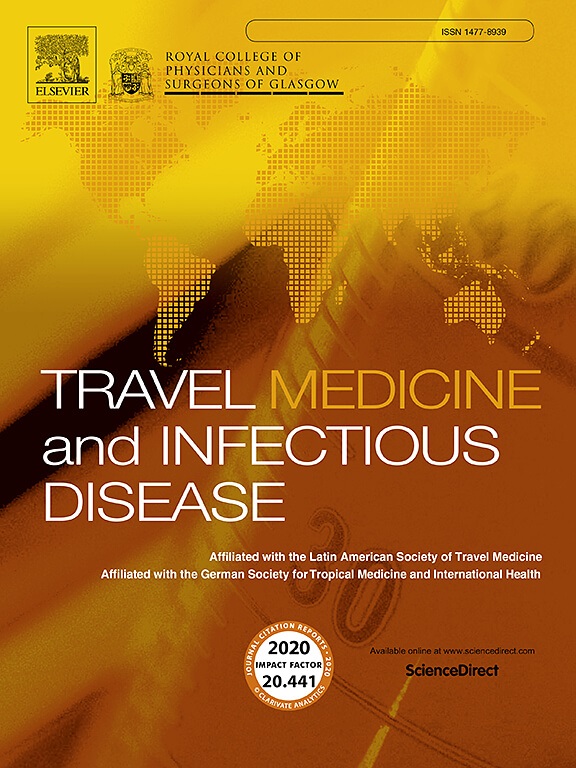非地方性片形吸虫病国家的输入性片形吸虫病:病例系列和文献回顾。
IF 4.7
3区 医学
Q1 INFECTIOUS DISEASES
引用次数: 0
摘要
背景:片形吸虫病是由肝片形吸虫和巨型片形吸虫引起的最容易被忽视的食源性人畜共患传染病之一。在过去的几十年里,由于大量的人类感染,它成为一个全球性的公共卫生问题。在旅行者和移民中也有片吸虫病的描述,与旅行医学相关。方法:报告2011 - 2023年我科确诊的4例输入性人片吸虫病病例。在MEDLINE和Embase上进行文献检索。我们纳入了在非流行国家诊断为输入性筋膜吸虫病的病例报告和病例系列,以总结诊断和治疗方法。结果:共检获输入性片形吸虫病46例,以东南亚(41.3%)和非洲(34.8%)为主要病例。40例(86.9%)患者出现症状,特别是低烧和腹痛。嗜酸性粒细胞增多占94.4%。血清学检查几乎全部阳性(36/37,97.3%),而粪便寄生虫学检查仅有少数阳性(5/32,15.6%)。12例经内镜摘除成虫,6例经肝活检或肝切除诊断为片吸虫病。应用三氯咪唑治疗33例,疗效良好。讨论:在非流行环境中,片吸虫病的诊断是复杂的,高度的怀疑指数是至关重要的。旅行者或移民中出现嗜酸性粒细胞增多、发热和肝脏病变应引起怀疑,血清学检测可证实诊断。尽管在许多国家无法获得,但三氯咪唑仍然是首选药物。本文章由计算机程序翻译,如有差异,请以英文原文为准。
Imported fascioliasis in non-endemic countries: a case series and review of the literature
Background
Fascioliasis is one of the most neglected foodborne zoonotic infectious disease, caused by the trematodes Fasciola hepatica and Fasciola gigantica. In last decades, it emerged as a public health problem worldwide, due to the substantial number of human infections. Fascioliasis has also been described in travellers and migrants, with relevance in Travel Medicine.
Methods
We reported four cases of imported human fascioliasis diagnosed in our Department between 2011 and 2023. Literature search was performed on MEDLINE and Embase. We included case reports and case series on patients diagnosed with imported fascioliasis in non-endemic countries to summarize diagnostic and therapeutic approaches.
Results
We retrieved 46 cases of imported fascioliasis, mostly acquired after stay in countries of South East Asia (41.3 %) and Africa (34.8 %). Forty patients (86.9 %) presented with symptoms, particularly low-grade fever and abdominal pain. Eosinophilia was found in 94.4 %. When performed, serology was positive in almost all patients (36/37, 97.3 %), while parasitological stool examination was positive only in a few cases (5/32, 15.6 %). In 12 cases, adult worm was removed by endoscopic technique, while in six cases fascioliasis was diagnosed after liver biopsy or resection. Triclabendazole was administered 33 cases, with excellent outcome.
Discussion
Diagnosis of fascioliasis is complex in non-endemic settings, and a high index of suspicion is crucial. The presence of eosinophilia, fever and hepatic lesions in travellers or migrants should rise suspicion, and serological tests may confirm the diagnosis. Triclabendazole remains the drug of choice, despite unavailability in many countries.
求助全文
通过发布文献求助,成功后即可免费获取论文全文。
去求助
来源期刊

Travel Medicine and Infectious Disease
PUBLIC, ENVIRONMENTAL & OCCUPATIONAL HEALTH-INFECTIOUS DISEASES
CiteScore
19.40
自引率
1.70%
发文量
211
审稿时长
49 days
期刊介绍:
Travel Medicine and Infectious Disease
Publication Scope:
Publishes original papers, reviews, and consensus papers
Primary theme: infectious disease in the context of travel medicine
Focus Areas:
Epidemiology and surveillance of travel-related illness
Prevention and treatment of travel-associated infections
Malaria prevention and treatment
Travellers' diarrhoea
Infections associated with mass gatherings
Migration-related infections
Vaccines and vaccine-preventable disease
Global policy/regulations for disease prevention and control
Practical clinical issues for travel and tropical medicine practitioners
Coverage:
Addresses areas of controversy and debate in travel medicine
Aims to inform guidelines and policy pertinent to travel medicine and the prevention of infectious disease
Publication Features:
Offers a fast peer-review process
Provides early online publication of accepted manuscripts
Aims to publish cutting-edge papers
 求助内容:
求助内容: 应助结果提醒方式:
应助结果提醒方式:


